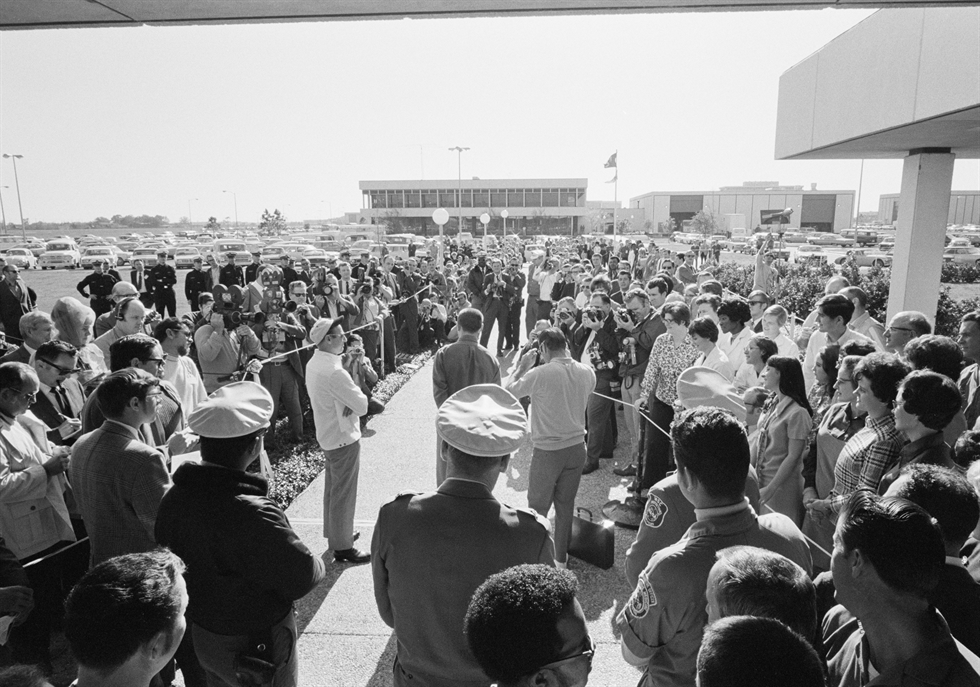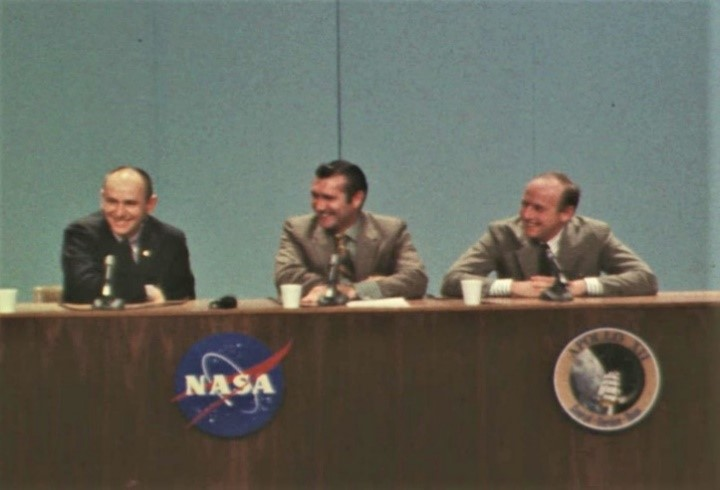Fifty Years Ago: Apollo 12 Astronauts Leave Quarantine
For the first time in nearly four weeks, Apollo 12 astronauts Charles “Pete” Conrad, Richard F. Gordon and Alan L. Bean stepped out into sunshine and breathed unfiltered air. Since their launch on Nov. 14, 1969, the trio had been inside their spacecraft for 10 days on a mission to the Moon and back, wore respirators during their recovery in the Pacific Ocean and housed in the Mobile Quarantine Facility during the trip from the prime recovery ship USS Hornet back to Houston and inside the Crew Reception Area of the Lunar Receiving Laboratory (LRL) at the Manned Spacecraft Center (MSC) in Houston, now Johnson Space Center in Houston.
Like the Apollo 11 crew before them, Conrad, Gordon and Bean exhibited no symptoms of any infections with lunar microorganisms, and managers declared them fit to be released from quarantine on Dec. 10, 1969. MSC Director Robert L. Gilruth, other managers and a crowd of well-wishers greeted the astronauts who completed the second Moon-landing mission. Their next few months would prove to be extremely busy, with many ceremonial functions.
MSC Director Robert Gilruth and others greet the Apollo 12 astronauts (left to right) Pete Conrad, Richard Gordon and Alan Bean as they emerge from the LRL’s Crew Reception Area.
Addressing the crowd gathered outside the LRL, Conrad commented that “the LRL was really quite pleasant,” but all three were glad to be breathing non-man-made air! While the men went home to their families for a short rest, work inside the LRL continued. Scientists began examining the first of the 75 pounds of rocks returned by the astronauts, as well as the camera and other hardware they removed from Surveyor 3 to evaluate the effects of 31 months exposed to the harsh lunar environment. Preliminary analysis of the TV camera that failed early during their first spacewalk on the lunar surface indicated that the failure was due to partial burnout of the Videocon tube, likely caused by the crew accidentally pointing the camera toward the sun. Other scientists busied themselves with analyzing the data returning from the Apollo Lunar Surface Experiment Package instruments Conrad and Bean deployed on the lunar surface. Mission planners examining the photographs taken from lunar orbit of the Fra Mauro area were confident that the next mission, Apollo 13, would be able to make a safe landing in that geologically interesting site—the first attempt to land in the lunar highlands.
Two days after leaving the LRL, Conrad, Gordon and Bean held their postflight press conference in the MSC auditorium. Addressing the assembled reporters, the astronauts first introduced their wives as their “number one support team” and then provided a film and photo summary of their mission, answering numerous questions. Among other things, the astronauts praised the spacesuits they wore during the Moonwalks, indicating that they worked very well and, looking to the future, saw no impediments to longer excursions on other missions. Their only concern centered around the ever-present lunar dust that clung to their suits, raising that as a potential issue for future lunar explorers.
Conrad, Gordon and Bean returned to NASA’s Kennedy Space Center on Dec. 17, where their mission began more than a month earlier (and nearly ended prematurely when their Saturn V rocket was struck by lightning—twice). Kennedy Director Kurt H. Debus presented each astronaut with a framed photograph of their launch in front of 8,000 workers assembled in the Vehicle Assembly Building. Of their nearly ill-fated liftoff, Conrad expressed his signature confidence, “Had we to do it again, I would launch exactly under the same conditions.”
Guenter Wendt and his pad closeout team had collected a piece of grounding rod from the umbilical tower, cut it into three short pieces and mounted them with the inscription, “In fond memory of the electrifying launch of Apollo 12,” presenting the mementos to each astronaut. Three days later, President Richard M. Nixon and First Lady Pat Nixon welcomed Conrad, Gordon and Bean and their wives Jane, Barbara and Sue, respectively, to a dinner at the White House. After dinner, they watched a film about the Apollo 12 mission, as well as the recently released motion picture “Marooned,” about three astronauts stranded in space. Nixon requested that the astronauts pay a visit to former President Lyndon B. Johnson, who for many years championed America’s space program, to brief him on their mission.
Left: The Alan Bean Day parade in Fort Worth. Right: Apollo 12 astronaut Bean and his family deluged by shredded office paper during the parade in his honor in Fort Worth. Image Credits: Fort Worth Star Telegram
On Dec. 22, the city of Fort Worth, Texas, honored native son Bean, with Conrad, Gordon and their families joining him for the Alan Bean Day festivities. An estimated 150,000 people lined the streets of the city to welcome Bean and his crewmates, dumping a blizzard of ticker tape and shredded office paper on the astronauts and their families during the parade. City workers cleared an estimated 60 tons of paper from the streets after the event.
On New Year’s Day 1970, Conrad, Gordon and Bean led the 81st annual Tournament of Roses Parade as Grand Marshals in Pasadena, California. Actress June Lockhart, an avid space enthusiast, interviewed them during the TV broadcast of the event.
Left: Apollo 12 astronaut Gordon rides in one of the Grand Marshal cars in the Rose Parade. Right: Actress June Lockhart (at left) interviews the Apollo 12 astronauts (left to right) Conrad, Gordon and Bean during the Rose Parade. Image Credit: emmyonline.com
As requested by Nixon during the White House dinner, Conrad, Gordon and Bean, as well as their wives, paid a visit to former president Johnson and First Lady Lady Bird Johnson at their ranch near Fredericksburg, Texas, on Jan. 14, 1970. The astronauts described their mission to the former president and Mrs. Johnson.
On Feb. 5, in a ceremony at the Pentagon, Admiral Thomas H. Moorer, chief of Naval Operations, presented Conrad, Gordon and Bean—all Navy Captains—with Distinguished Service Medals for their accomplishments. In turn, the astronauts presented Moorer with his personal flag that they carried with them during the Moon mission. Eleven days later, the three astronauts, accompanied by their wives and a NASA and State Department entourage, departed Ellington Air Force Base in Houston for a 38-day, 20-country around-the-world presidential goodwill tour, dubbed the “Bullseye World Tour” in honor of the pinpoint landing they made on the Moon.
Left: The Apollo 12 astronauts and their wives visiting the former president and Mrs. Johnson at the LBJ Ranch. Right: The Apollo 12 astronauts present Admiral Moorer (at left) with his personal flag that they carried on their mission.
The distribution of the Apollo 12 lunar samples to selected investigators began on Jan. 7, 1970, coincident with the First Lunar Science Conference held Jan. 5-8 at the Albert Thomas Convention Center in Houston. While the conference focused on preliminary results from the Apollo 11 samples, some investigators received their first samples from the second landing mission, while others received them by registered mail. In all, scientists received 28.6 pounds of Apollo 12 samples for investigation. At the end of the study period, they returned 23.7 pounds, having only destroyed four pounds during various experiments. On Jan. 7, managers lifted the quarantine on the Surveyor 3 parts returned by the astronauts, allowing scientists to examine them under laboratory conditions for the effects of 31 months on the lunar surface and the impact of the Lunar Module’s descent engine during approach and landing. NASA published a summary of their findings in 1972.
Left: Sign welcoming scientists to the Apollo 11 Lunar Science Conference. Right: A scientist examines the Surveyor 3 camera returned by the Apollo 12 astronauts.
Managers released the Apollo 12 Command Module Yankee Clipper from quarantine and shipped it back to its manufacturer, North American Rockwell in Downey, California, on Jan. 12. Engineers there completed a thorough inspection of the spacecraft and eventually prepared it for public display. NASA transferred Yankee Clipper to the Smithsonian Institution in 1973, and today the capsule resides at the Virginia Air and Space Center in Hampton, Virginia.
Left: The Apollo 12 Command Module Yankee Clipper arrives at the North American Rockwell facility. Middle: Yankee Clipper at North American Rockwell in Downey. Right: Yankee Clipper at the Virginia Air and Space Center. Image Credit: National Air and Space Museum
While the Apollo 12 astronauts continued their post-mission touring, Apollo 11 commander Neil A. Armstrong joined Bob Hope’s United Service Organizations' (USO) Christmas tour in late December 1969. Armstrong participated in several shows at venues in Vietnam, Thailand and Guam, kidding around with Hope and answering questions from the assembled service members. He received standing ovations and spent much of his time shaking hands with the troops. The USO troupe also visited the hospital ship USS Sanctuary stationed in the South China Sea.
Left: Neil Armstrong (left) and Bob Hope perform for the troops in Korat, Thailand. Right: Armstrong (in a blue flight suit) shakes hands with servicemen in Long Binh, Vietnam.
All image credits NASA unless otherwise noted.











